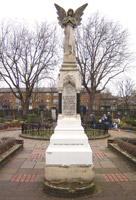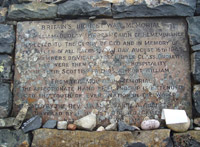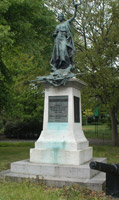War Memorials
You will probably be familiar with the World War memorials that appear in virtually every corner of the UK. In fact, most date from the First World War and were later adapted to include those who served in the Second. Generally, these were erected by public subscription, though there are also memorials created by companies or civic societies: look, for example, for plaques at major railway stations.
The public commemoration of war is, however, rather older than 1918. In Glasgow and Salford there are notable – if rare – monuments remembering the Crimean War; there are also memorials, albeit often small, private, and hidden away in churches, to individuals who fought in the Napoleonic wars.
Celebrating victory
The take-off point for widespread public commemoration of conflict, however, was probably what is commonly called the ‘Boer’ War (1899-1902). This memorial shows the celebratory statue erected by Islington’s public to remember that borough’s soldiers. The figure represents ‘Victory’. Such gestures helped to bind together communities and were sources of civic pride. In this case, the statue also shows us the power of imperialism in the Victorian popular imagination.

Commemorating casualties
But it was only during World War I that a shift from celebrating victories to commemorating war casualties became widespread. Because the First World War also saw an extension of the scale of conflict, we also begin to see the occasional unusual memorial. This is the Poplar monument from 1917 that mourns the death of 18 children in an air raid. This reminds us that it wasn’t just World War II in which people on the ‘home front’ were under threat from the enemy.
Photo of Poplar memorial courtesy of Fin Fahey. Some rights reserved

The fabric of national life
This plaque on Ben Nevis is the highest memorial in Britain. But that’s not the only reason it’s remarkable. It refers solely to the Second World War, and its inscription is unusually broad – paying tribute to the fallen ‘of all races’ (presumably including the enemy). Some of that might be attributed to the people who established it, but even then there’s surely an extraordinary back-story. For the local or family historian, it would surely be a terrific mission to find out how a Bible study class from the West Midlands came to erect a war memorial on top of a mountain in Scotland!
Photo of Ben Nevis memorial plaque courtesy of coda on Flicker. Some rights reserved
Symbolising values
We may be somewhat ambivalent about war memorials, though. One could argue that World War II was fought for ideals of democracy and freedom, but previous conflicts are more problematic. For instance, many Boer War memorials fell into disrepair or were taken down in the twentieth century, perhaps as an unintentional consequence of reflexive post-imperial guilt. However, such memorials are arguably still significant in public memory, if only to remind us of the part that conflict has played in changing national life.
They are vital historical sources that offer tantalising clues about past belief systems: witness the frequent references to God, nation, king, and empire on First World War memorials. They also illustrate altering (and persisting) artistic tastes: compare the Islington memorial – which is an example of art nouveau – with the Poplar one, which reaches back into the nineteenth century in its determinedly Victorian Gothic symbolism.
Many British war memorials are, however, under threat from neglect and vandalism, according to the War Memorials Trust. Perhaps that ambivalence about the public commemoration of war has caused misunderstandings about what they represent, or maybe the public, for other reasons, does not appreciate their history? What do you think?
Taking it further
The public remembrance of war is a live debate in the historical discipline and in the heritage community. If you are interested, you can explore the topic of war and remembrance in the OU’s free online learning space. Our new online course, Heritage, whose heritage? (A180), gives a more fulsome introduction. The two total wars of the twentieth century are the subject of the course Total war and social change: Europe 1914-55 (AA312). We also offer an appealing starter course for budding family historians, which covers some of these questions: Start writing family history (A173).

Rate and Review
Rate this article
Review this article
Log into OpenLearn to leave reviews and join in the conversation.
Article reviews